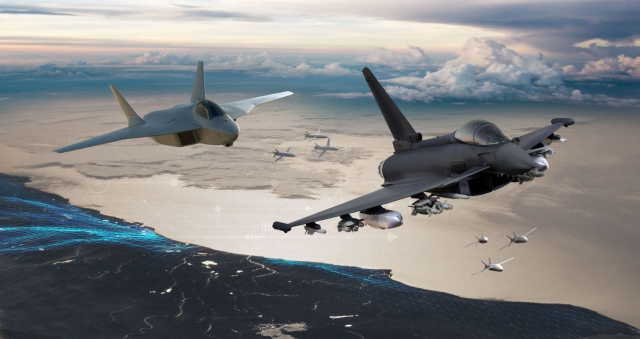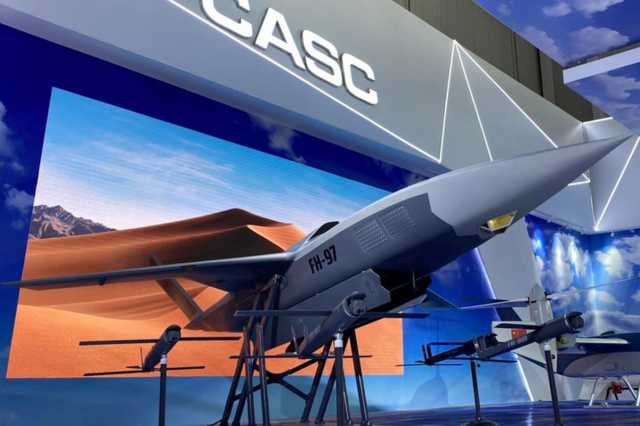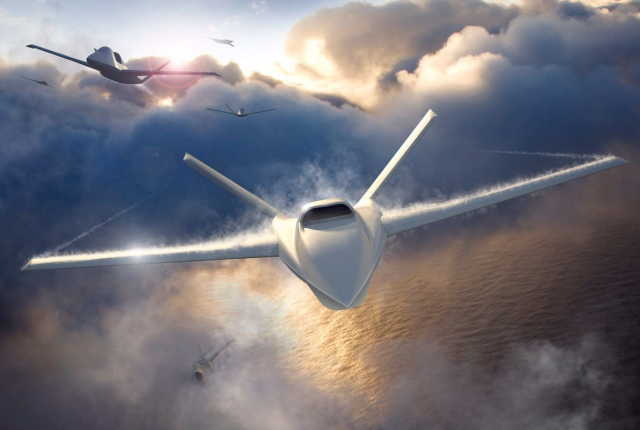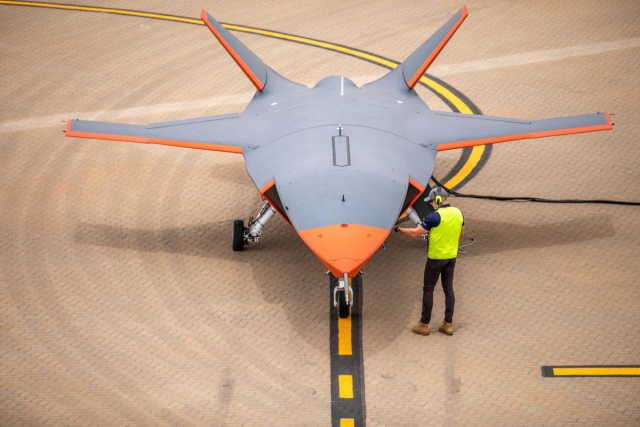Your attention is invited to the final part of the article published by the British resource shephardmedia.com . Recall that in the first part , the author, Gordon Arthur, outlined the essence of the concept of a loyal wingman and presented some programs currently being implemented in the bowels of the US Air Force. In the final part, international approaches to solving the problem of interaction between manned and unmanned aircraft systems (MUM-T) will be analyzed.
[In the text, notes IVi are taken in square brackets]
Joint programs of the faithful follower
Airbus, Dassault Aviation, Indra Sistemas and Thales are collaborating on the development of the Franco-German-Spanish combat aviation system of the future (Future Combat Air System, FCAS) of the sixth generation, which should appear in 2040. FCAS will include at least two classes of remote carriers, with Airbus, supported by MBDA, responsible for this part.
Last [2021], Airbus reached an important MUM-T milestone when the German Eurofighter fighter assigned tasks to two Do-DT25 target drones (acting as surrogate remote carriers). Airbus is also considering the [military transport aircraft] A400M as a launcher for remote FCAS carriers, the successful launch of which took place in 2021.
Just to confuse the situation, the UK also calls its sixth-generation fighter program FCAS, the heart of which is Tempest from BAE Systems, which will replace Typhoon by 2035. The Tempest group includes BAE Systems, Leonardo, MBDA, Rolls-Royce and the RAF. In December 2021, it was reported that a partnership between Italy, Sweden and the United Kingdom should agree on a program of faithful led FCAS in 2022.

This computer image shows fourth and fifth generation fighter jets working alongside smaller UAVs. Airbus is responsible for developing remote carriers for the European FCAS program. (Image: Airbus)Within the framework of the project of a light affordable new combat aircraft [Lightweight Affordable Novel Combat Aircraft], a separate area of work with the faithful wingman Mosquito was led by the Office of Rapid Capabilities of the Royal Air Force.
Starting in 2019, with a budget of $41 million, Spirit AeroSystems Belfast has partnered with Northrop Grumman UK and Intrepid Minds.
However, on July 24, the UK Ministry of Defense announced the cancellation of the Mosquito program. It has made "significant progress and gained significant value," but "the analysis concluded that more useful capabilities and profitability seem achievable by exploring smaller, less expensive, but still highly effective additional capabilities." This sudden reduction should not affect FCAS' efforts to use loyal wingmen after 2035.
If the technology is implemented, loyal wingmen will not wait until two European fighters of the next generation enter service 15-20 years later. In the end, the elements are expected to be deployed together with Typhoons and Rafales.
D. Barry [ see part I ] was asked about Russia. "I'm sure there are ambitions, but I think the problem with the Russians to some extent is that they have to play catch-up in the entire inhabited environment." Investments in unmanned technologies have fallen catastrophically since the collapse of the Soviet Union, but today Russia has relevant elements, such as the S-70 Hunter and the Su-57 fighter. In 2021, Moscow announced plans to develop a two-seat Su-57 capable of controlling such a UAV.
Being a relative newcomer in the field of UAVs, Turkish products cause a furor. Currently, Baykar is assembling a Bayraktar MIUS (Kizilelma) jet prototype with a faithful wingman, whose take-off weight is 5.5 tons. Its first flight is expected in 2023, and the flight duration will be 5 hours. In addition to being a partner of the next-generation fighter TF-X , he will even be able to work with the Turkish helicopter carrier LHD Anadolu.
Diverse approaches
In the Asia-Pacific region, Australia's Loyal Wingmen program has the highest status. In March [2022], an 11.7 m long fighter jet of the Royal Australian Air Force [RAAF] was named the MQ-28A Ghost Bat. Having made its maiden flight on February 27, 2021, it represents Boeing's largest investment in a new UAV program outside the United States.
Boeing calls it the Airpower Teaming System. Work on three prototypes has been completed, and Canberra recently confirmed investments in seven additional devices. "The Ghost Bat team is confident that this potential will be transformed into cost—effective and combat-ready capabilities for Australia," Boeing said.
The MQ-28A has a flight range of 3,700 km and an internal payload bay. Production models may begin production at the new Toowoomba plant in the mid-2020s, and they will be able to fly alongside the F-35A and Super Hornets of the Royal Australian Air Force.
Air Force Commander and Air Vice Marshal Robert Denney said: "The introduction of the Airpower Teaming System into the Air Force system will be a turning point, an extremely advanced capability for Australia… No other country has developed the possibility of combining air forces, and we are already on the way to its production."
Boeing representatives added: "Aircraft continue to be produced along with the development of mission and payload systems. Boeing is also rapidly advancing the verification of digital twin simulations. Digital engineering is the fundamental basis of the Airpower Teaming System approach to the task of implementing the advanced design and development of this program, as well as the production of an affordable device. Using the digital environment, Boeing Defense Australia and the Royal Australian Air Force can develop and test autonomous behavior in operational scenarios and against threats. This ensures maneuverability and economy. Indeed, the digital counterpart of a real airplane has already flown thousands of times."
Experts are wondering whether there will be difficulties in networking assets such as the F-35A, since the United States is paranoid about protecting advanced technologies from the point of view of intellectual property and security. However, Boeing does not consider this a problem, claiming that it will provide "the highest level of operational capabilities."
The Ghost Bat project is also attractive outside of Australia. "Boeing sees a significant global market for this type of capability that increases combat mass to match or exceed future threats, but doing so at an affordable price with less risk to crewed systems. Ghost Bat provides a disruptive advantage, and the advantage of a digitally designed aircraft is that we can quickly adapt to new changes and requirements. Therefore, we expect Ghost Bat to continue to evolve for at least the next 10 years."India also has a nascent program of loyal wingmen.
The Hindustan Aeronautics Limited company in 2018 launched the fighter of the combat Air Teaming System [Combat Air Teaming System, CATS] Warrior. A mock-up of the 9.2-meter CATS Warrior was presented at Aero India 2021, and the company hopes that the prototype will fly in 2024. However, given India's enormous difficulties in developing conventional MALE-class UAVs, sources do not expect rapid progress.
Elsewhere, Mitsubishi Heavy Industries is leading Japan's efforts to develop the sixth-generation F-X/F-3 fighter. Last year, the Japanese Defense Ministry announced that it would begin developing UAVs launched from the F-X. Being forward, the drone will be able to detect enemy fighters or missiles, giving FX the opportunity to attack. In the future, the UAV itself will carry air-to-air missiles.
The Japanese Ministry of Defense believes that each group will consist of one F-X and three UAVs. They hope to conduct flight tests in 2024 in order to deploy drones in 2035 together with FX, which may well receive British technical support.
China is very secretive, but D. Barry said: "Given the breadth of general defense aerospace research, I would be surprised if they didn't do it, because it seems they are doing absolutely everything!"There are hints too.
At the Airshow China 2021, the Chinese Aerospace Science and Technology Corporation showed a mock-up of the FH-97. Resembling a faithful wingman, the FH-97 jet has an inconspicuous trapezoidal fuselage and a large internal compartment for weapons.

FH-97, a low-profile UAV developed by CASC in China. Despite the fact that this is just a mock-up presented in 2021, it has all the signs of a faithful wingman and indicates that China is pursuing such unmanned systems.
Another clue — seat fighter J-20, the prototype of which is in October 2021 conducted tests on the high-speed taxiing. Designed for the PLA, its precise function remains speculative. However, it's definitely not a trainer, and a second crew member can potentially drive a true slave.
Grounding expectations
None of the air force never get as many planes as they need, so the faithful slave will increase the fleets. However, is there a risk that prudent policy might see it as a replacement for the fighters? Of course, no military does not want the money that would have gone to the fighters were directed to additional aircraft is Rob Peter to pay Paul.
New technologies do support aircraft to more viable and cost-effective, although D. Barry warned that "we are not there yet, because of various technical issues still need to be clarified. For example, peer-to-peer environment class will be challenged frequency spectrum. You will work all of your happy data channels so that no one tried to get in there and cause problems. Thus, if you rely on the data channels to continuously control these things, then this vulnerability".
Conversely, how far and how fast these platforms will go from the point of view of artificial intelligence (AI)? Whether we eventually do a standalone system?
D. Barry continued: "I'm a little skeptical about all this, in the sense that there is a combination of reliability and predictability of the software, public acceptance and legal issues. There are a number of things that revolve around". The problem of public recognition is poured back into the debate on killer robots, raising moral and ethical issues concerning AI.
D. Barry suggests that the introduction of the faithful slave will be "gradual", starting with the low-hanging fruit, and then rising above the tree. Thus, first, we can just see how fighters release smaller UAVs, but top solutions appear longer.
D. Barry came to the conclusion that we are now at the stage of transition "from experiment through the valley of death to something that can be useful to use and applicable in the field. That's where we are in the moment. The technology looks really promising. It invested heavily, and, ceteris paribus, I expect that by the end of this decade, things will start to be used".
Materials resource shephardmedia.com
The article contains solely the author's assessment and do not reflect the position of the editorial Board IV


